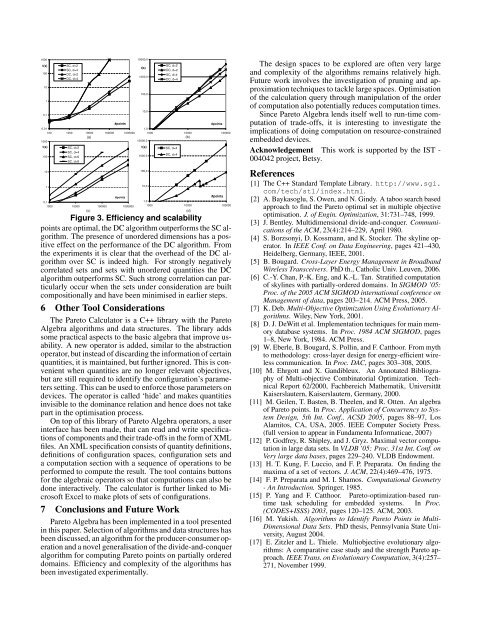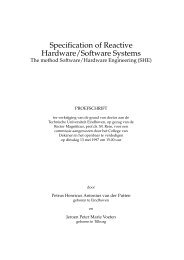A Calculator for Pareto Points
A Calculator for Pareto Points
A Calculator for Pareto Points
Create successful ePaper yourself
Turn your PDF publications into a flip-book with our unique Google optimized e-Paper software.
1000<br />
t(s) SC, d=2<br />
SC, d=4<br />
100<br />
DC, d=2<br />
DC, d=4<br />
10<br />
1<br />
0,1<br />
#points<br />
10000,0<br />
0,01<br />
1,0<br />
100 1000 10000 100000 1000000 1000 10000 100000<br />
(a) (b)<br />
1000<br />
10000,0<br />
t(s) SC, d=2<br />
SC, d=4<br />
100<br />
SC, d=6<br />
SC, d=8<br />
10<br />
1<br />
t(s)<br />
1000,0<br />
100,0<br />
10,0<br />
SC, d=2<br />
DC, d=2<br />
SC, d=4<br />
DC, d=4<br />
t(s) SC, d=4<br />
#points<br />
#points<br />
#points<br />
0,1<br />
1,0<br />
1000 10000 100000 1000000 1000 10000 100000<br />
(c) (d)<br />
Figure 3. Efficiency and scalability<br />
points are optimal, the DC algorithm outper<strong>for</strong>ms the SC algorithm.<br />
The presence of unordered dimensions has a positive<br />
effect on the per<strong>for</strong>mance of the DC algorithm. From<br />
the experiments it is clear that the overhead of the DC algorithm<br />
over SC is indeed high. For strongly negatively<br />
correlated sets and sets with unordered quantities the DC<br />
algorithm outper<strong>for</strong>ms SC. Such strong correlation can particularly<br />
occur when the sets under consideration are built<br />
compositionally and have been minimised in earlier steps.<br />
6 Other Tool Considerations<br />
The <strong>Pareto</strong> <strong>Calculator</strong> is a C++ library with the <strong>Pareto</strong><br />
Algebra algorithms and data structures. The library adds<br />
some practical aspects to the basic algebra that improve usability.<br />
A new operator is added, similar to the abstraction<br />
operator, but instead of discarding the in<strong>for</strong>mation of certain<br />
quantities, it is maintained, but further ignored. This is convenient<br />
when quantities are no longer relevant objectives,<br />
but are still required to identify the configuration’s parameters<br />
setting. This can be used to en<strong>for</strong>ce those parameters on<br />
devices. The operator is called ‘hide’ and makes quantities<br />
invisible to the dominance relation and hence does not take<br />
part in the optimisation process.<br />
On top of this library of <strong>Pareto</strong> Algebra operators, a user<br />
interface has been made, that can read and write specifications<br />
of components and their trade-offs in the <strong>for</strong>m of XML<br />
files. An XML specification consists of quantity definitions,<br />
definitions of configuration spaces, configuration sets and<br />
a computation section with a sequence of operations to be<br />
per<strong>for</strong>med to compute the result. The tool contains buttons<br />
<strong>for</strong> the algebraic operators so that computations can also be<br />
done interactively. The calculator is further linked to Microsoft<br />
Excel to make plots of sets of configurations.<br />
7 Conclusions and Future Work<br />
<strong>Pareto</strong> Algebra has been implemented in a tool presented<br />
in this paper. Selection of algorithms and data structures has<br />
been discussed, an algorithm <strong>for</strong> the producer-consumer operation<br />
and a novel generalisation of the divide-and-conquer<br />
algorithm <strong>for</strong> computing <strong>Pareto</strong> points on partially ordered<br />
domains. Efficiency and complexity of the algorithms has<br />
been investigated experimentally.<br />
1000,0<br />
100,0<br />
10,0<br />
DC, d=4<br />
The design spaces to be explored are often very large<br />
and complexity of the algorithms remains relatively high.<br />
Future work involves the investigation of pruning and approximation<br />
techniques to tackle large spaces. Optimisation<br />
of the calculation query through manipulation of the order<br />
of computation also potentially reduces computation times.<br />
Since <strong>Pareto</strong> Algebra lends itself well to run-time computation<br />
of trade-offs, it is interesting to investigate the<br />
implications of doing computation on resource-constrained<br />
embedded devices.<br />
Acknowledgement This work is supported by the IST -<br />
004042 project, Betsy.<br />
References<br />
[1] The C++ Standard Template Library. http://www.sgi.<br />
com/tech/stl/index.html.<br />
[2] A. Baykasoglu, S. Owen, and N. Gindy. A taboo search based<br />
approach to find the <strong>Pareto</strong> optimal set in multiple objective<br />
optimisation. J. of Engin. Optimization, 31:731–748, 1999.<br />
[3] J. Bentley. Multidimensional divide-and-conquer. Communications<br />
of the ACM, 23(4):214–229, April 1980.<br />
[4] S. Borzsonyi, D. Kossmann, and K. Stocker. The skyline operator.<br />
In IEEE Conf. on Data Engineering, pages 421–430,<br />
Heidelberg, Germany, IEEE, 2001.<br />
[5] B. Bougard. Cross-Layer Energy Management in Broadband<br />
Wireless Transceivers. PhD th., Catholic Univ. Leuven, 2006.<br />
[6] C.-Y. Chan, P.-K. Eng, and K.-L. Tan. Stratified computation<br />
of skylines with partially-ordered domains. In SIGMOD ’05:<br />
Proc. of the 2005 ACM SIGMOD international conference on<br />
Management of data, pages 203–214. ACM Press, 2005.<br />
[7] K. Deb. Multi-Objective Optimization Using Evolutionary Algorithms.<br />
Wiley, New York, 2001.<br />
[8] D. J. DeWitt et al. Implementation techniques <strong>for</strong> main memory<br />
database systems. In Proc. 1984 ACM SIGMOD, pages<br />
1–8, New York, 1984. ACM Press.<br />
[9] W. Eberle, B. Bougard, S. Pollin, and F. Catthoor. From myth<br />
to methodology: cross-layer design <strong>for</strong> energy-efficient wireless<br />
communication. In Proc. DAC, pages 303–308, 2005.<br />
[10] M. Ehrgott and X. Gandibleux. An Annotated Bibliography<br />
of Multi-objective Combinatorial Optimization. Technical<br />
Report 62/2000, Fachbereich Mathematik, Universität<br />
Kaiserslautern, Kaiserslautern, Germany, 2000.<br />
[11] M. Geilen, T. Basten, B. Theelen, and R. Otten. An algebra<br />
of <strong>Pareto</strong> points. In Proc. Application of Concurrency to System<br />
Design, 5th Int. Conf., ACSD 2005, pages 88–97, Los<br />
Alamitos, CA, USA, 2005. IEEE Computer Society Press.<br />
(full version to appear in Fundamenta In<strong>for</strong>maticae, 2007)<br />
[12] P. Godfrey, R. Shipley, and J. Gryz. Maximal vector computation<br />
in large data sets. In VLDB ’05: Proc. 31st Int. Conf. on<br />
Very large data bases, pages 229–240. VLDB Endowment.<br />
[13] H. T. Kung, F. Luccio, and F. P. Preparata. On finding the<br />
maxima of a set of vectors. J. ACM, 22(4):469–476, 1975.<br />
[14] F. P. Preparata and M. I. Shamos. Computational Geometry<br />
- An Introduction. Springer, 1985.<br />
[15] P. Yang and F. Catthoor. <strong>Pareto</strong>-optimization-based runtime<br />
task scheduling <strong>for</strong> embedded systems. In Proc.<br />
(CODES+ISSS) 2003, pages 120–125. ACM, 2003.<br />
[16] M. Yukish. Algorithms to Identify <strong>Pareto</strong> <strong>Points</strong> in Multi-<br />
Dimensional Data Sets. PhD thesis, Pennsylvania State University,<br />
August 2004.<br />
[17] E. Zitzler and L. Thiele. Multiobjective evolutionary algorithms:<br />
A comparative case study and the strength <strong>Pareto</strong> approach.<br />
IEEE Trans. on Evolutionary Computation, 3(4):257–<br />
271, November 1999.
















